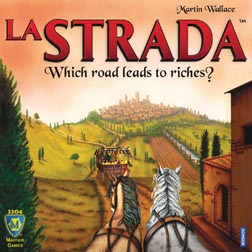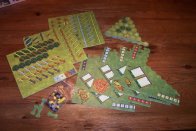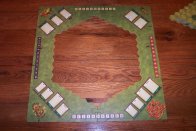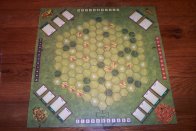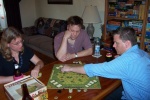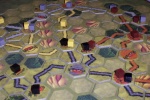
|
La Strada A game by Martin Wallace Published by Mayfair Games, Inc. and Kosmos Players: 2 to 4 Time: 30 minutes Reviewed by Ed Rozmiarek |

|
In La Strada the players are Italian merchants during the glory days of northern Italy. They are seeking new markets for their goods by connecting their workshops to the local towns and villages. By having connections to many markets, the players earn more gold for their goods. However, if the market is flooded with goods of multiple players, the markets earn less gold than if they had a monopoly. The player who earns the most gold becomes the merchant prince and the "King of La Strada."
La Strada was designed by Martin Wallace who is known for designing some very meaty "gamer's games" such as Liberté and Princes of the Renaissance and countless train games such as Age of Steam, Volldampf and Pampas Railroads. He has also done several lighter games such as the fun card game Und Tschüss! and the very forgetable Secrets of the Tombs. La Strada falls on the lighter end of the scale but it definitely is not fluff. In fact, La Strada could have easily been themed as a train game and marketed as a beginner's train game.
Components:
The La Strada components are very nice and what you would expect from a German produced game. This continues the Mayfair dichotomy of high quality, German produced games vs. their lower quality domestically produced games.
The cardboard pieces are heavy duty and the die cutting of the pieces is very clean and the pieces come out easily. Most of the pieces are duel sided road hexes that the players use to connect their workshops to the settlements. On one side of the hexes there is a straight road and on the other a curved road with a 120 degree turn. There is a plastic insert in the box that holds all of the components very neatly. And of course, there are the standard wooden cubes which in this case are use by the players to mark their markets in the cities.
The board is composed of a hex based grid in the shape of a large hex. The hexes are marked as either plains, woods or hills. There are 19 dots that indicate the locations of the settlements.
In an effort to increase replayability, the board is variable and randomized prior to each game. During setup, the square board frame is constructed to hold the main board pieces. The frame has four corners that are held together by connector pieces. (See picture at right) On the frame there is a resource track for each player and the scoring areas for each type of settlement. Within the frame, the players construct the board by placing six triangler shaped pieces, each of which is covered with hexes. There is a key board piece that must be placed so that the "extra" hex will be in the center of the board and then the other five pieces of the board are shuffled and placed in the frame.
Game play:
Setup:
After setting up the board, the 19 settlements are randomized and placed on the board
on the spaces marked with a dot.
There are 4 cities and 5 each of the towns, villages and hamlets.
A starting player is chosen and that player places his workshop on the board followed by each
other player in clockwise order.
The restrictions for the workshop placement are:
- The workshop must be placed on a plains hex.
- The workshops may not be next to each other. There must be at least one space between each workshop.
Player's turn: A player's turn consists of two parts:
- Get 6 resources
At the start of each turn, the player gets six resource points to build track with on his turn. Unused resources may by held over to the next turn, but no player may have more than 10 resource points. Therefore, if a player carries over more than four resources to the next turn, he will lose the excess resources over 10. - Build track
The player may spend as many of his resource points as he wishes to build roads to expand his network to additional settlements. The building costs for each type of road segment is given in the chart to the right. There are a few restrictions for road building, but they are pretty straight forward.Building Costs Tile type Cost Tile image Plains 2 
Woods 3 
Hills 4 
- A player's first road must start at his workshop. Once he connects to one settlement, additional roads may start with the workshop or any settlement the player has already connected.
- A road must be completed and connect to a settlement within the turn it was started. Players may not leave partial, incomplete roads.
- Players may not connect to a settlement more than once.
- Players must use the correct tile type for that the hex type. (i.e. Plain tiles placed on plains hexes, forest tiles on forest hexes, etc.)
- Players may not build on a hex that has another tile (a player's road tile or settlement) on it nor may they connect to another player's workshop.
- A player may connect to more than one new settlement on a turn if he has enough building points.
Game end: The game end is simple. On his turn, if one player cannot connect to a new settlement for any reason (no market cubes, incorrect tile types, lack of resources, etc), the game ends immediately. No one gets any more turns and the game is scored.
Scoring:
| Market Scoring | ||||
| Number of markets | ||||
| Settlement | 1 | 2 | 3 | 4 |
| City | 5 | 4 | 3 | 2 |
| Town | 4 | 3 | 2 | 1 |
| Village | 3 | 2 | 1 | 0 |
| Hamlet | 2 | 1 | 0 | 0 |
So, at the end of the game, for each settlement, you take the cubes off of the settlement hex and place them in the corresponding scoring box. After you have removed all of the cubes from the board and placed them in the correct boxes, it is a simple matter to total the players' points and determine the winner.
Comments:
Although the medieval market theme fits the game, no matter how hard I try, I can't stop thinking that La Strada is really a light train game. You have your beginning city and you are building tracks to serve other cities. However, unlike heavier train games, there is no company stock worry about, no goods to transport and no income to manage/increase. It reminds me of a little of Magna Grecia or Age of Steam but with simplified building costs, standard income and single focus (connecting markets).
Although La Strada only has one focus, building roads to connect markets, there are many decisions to be made during the game and placement of the roads can be critical. The main focus for most players will be connecting to the higher paying cities and towns. This is usually good, but while doing so, you need to make sure you don't get cut off from big areas of the board. The players must always be watching the entire board and making sure they have the ability to grow their network. Getting shut out of an area or being forced to take a long, expensive route can be tough. The players should always be looking for ways to shut out the other players and control a monopoly in a settlement. Many times this is tough, but well worth it if it can be done.
Most of the games I have played have been very close. For example, one 4-player game had scores in the range of 20 to 24 and a 3-player game had the second and third players one point behind the winner. However, one game did demonstrate the need to keep your options open. In this game, one player got shut out from a large part of the board and as such was not able to get as many markets placed. This player came in last, 13 points off the lead and 8 points behind the third place player.
La Strada has played well with 2 through 4 players, but the feel of the game changes with the different numbers. With four players, the board is very crowded and challenging and the players really must watch for getting cut off. With three, the board is more open with fewer roads and as such, it is easier to get to most of the board. With two players, the game feel changes drastically. In this case, there are a few special rules. First only one player may connect to each settlement. Second, the players start with two workshops and third, the player who places the last workshops builds roads first. This makes the game really feel like just a building race as the games seemed to come down to who connected to the most towns and villages as the cities were usually split two a piece.
Note: In our two players games (granted, a small number of games), the first player to build roads always won. We didn't play enough to make any claims, but I would be interested in hearing if anyone else sees this trend.
Summary:
La Strada fits an interesting niche.
The 30 minute playing time gives the impression that La Strada is only a filler game
and I can see it getting played a lot as such.
However, it's not just a light filler that doesn't require much thinking
that one usually looks for as a game night opener or closer.
There is a lot going on in La Strada and players must be on their toes while playing.
I can also see La Strada being played a lot with newer gamers as "gateway" game.
If a new gamer does well at and enjoys La Strada, they may be ready to move up to a
more complicated game such as Magna Grecia or a medium weight train game.
One other place La Strada fits is the "lunch time" game slot. We play a lot of games during lunch at work and are always looking for new games that fit the restrictions of lunch time playing. The short playing time will easily allow the game to be played during a short lunch period and with quicker, experienced players, I can see getting two games in during a hour.
| Other Web information: |
This page viewed
E-mail Ed Rozmiarek with questions or problems concerning this page.
Copyright © 2004, Ed & Susan Rozmiarek
